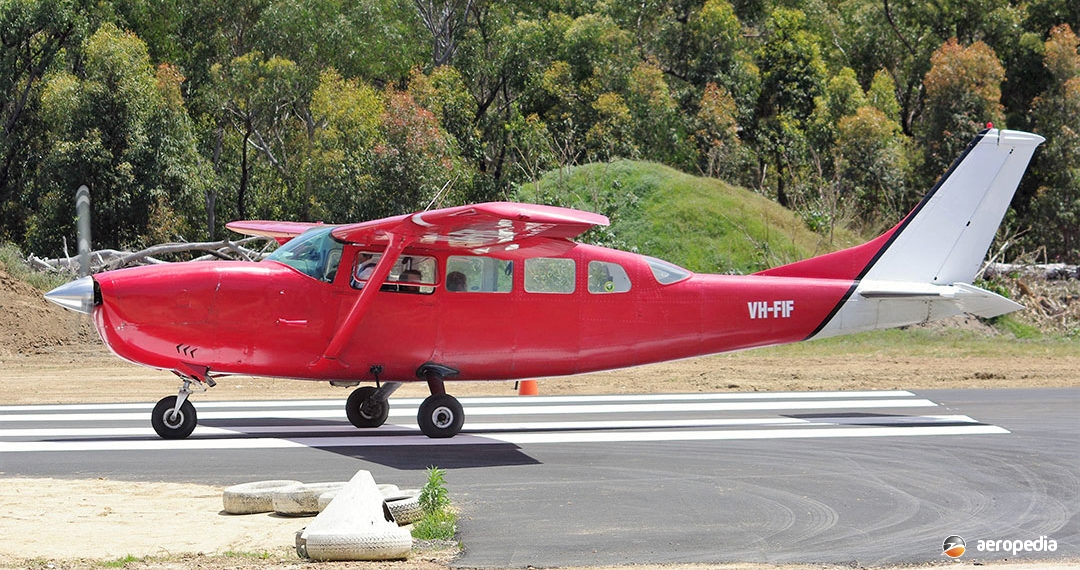Photograph:
Cessna 207 Skywagon VH-FIF (c/n 20700095) at Wedderburn, NSW (David C Eyre)
Country of origin:
United States of America
Description:
Light utility aircraft
Power Plant:
One 224 kw (300 hp) Continental IO-520-F six-cylinder horizontally-opposed air-cooled engine
Specifications:
- Wingspan: 10.92 m (35 ft 10 in)
- Length: 9.8 m (32 ft 2 in)
- Height: 2.92 m (9 ft 7 in)
- Wing area: 16.2 m² (174 sq ft)
- Max speed at sea level: 278 km/h (168 mph)
- Cruising speed at 75% power at 1,981 m (6,500 ft): 265 km/h (158 mph)
- Cruising speed at 2,438 m (8,000 ft): 251 km/h (156 mph)
- Economical cruising speed at 3,048 m (10,000 ft): 211 km/h (131 mph)
- Initial rate of climb: 247 m/min (810 ft/min)
- Service ceiling: 4,054 m (13,300 ft)
- Range at 265 km/h (158 mph) at 1,981 (6,500 ft): 722 km (585 miles)
- Empty weight: 942 kg (2,076 lb)
- Loaded weight: 1,729 kg (3,812 lb)
History:
The Cessna 207 Skywagon was basically a lengthened development of the Cessna 206 series designed to improve load-carrying capability whilst retaining the operating economics of that aircraft. With a length of 9.7 m (31 ft 9 in), the Model 207 could accommodate almost a tonne of cargo in the 5.48 m³ (165 cub ft) available in the fuselage. The power plant was a Continental IO-520F with fuel injection, which provided 224 kw (300 hp) for take-off and a maximum of 213 kw (285 hp) continuously.
Early versions provided accommodation for a pilot and up to six passengers. A separate baggage compartment was located forward of the cabin, and there were two entrance doors on the port side. An optional double cargo door on the right side was available. As with all Cessnas, aerodynamic and other improvements were made to the design to increase performance, economy, and load-carrying ability. As new models appeared a letter was usually added to the type number.
The prototype of the 207 series was flown for the first time on 11 May 1968, and the first production example followed on 3 January 1969. Production deliveries commenced shortly after. In 1977 the Model 207 was fitted with a three-blade propeller as standard equipment on both the normally aspirated and turbocharged versions, with the latter engine (the TSIO-520-G) delivering 231 kw (310 hp) for take-off at 2,700 rpm.
In 1978 the Stationair 7 and Turbo Stationair 7 replaced the Skywagon 207 on the production line and, although it was essentially the same aircraft, the names were changed to distinguish them from other models in the Cessna range. As with the Model 206, the only change in 1979 was an increase in fuel capacity to 418 litres (92 Imp gals).
In 1980 the Stationair 7 became the Stationair 8, which provided an extra seat so that a pilot and seven passengers could be carried. In the utility role the new model could carry 771 kg (1,745 lb) of cargo. A fibreglass cargo-pack could be carried under the fuselage to give an additional capacity of 136 kg (300 lb). A total of 788 Model 207s had been completed when production ceased in 1985.
One after market modification of the type was the installation of a Pratt & Whitney PT-6 turboprop, a number of examples being converted around the world by Soloy to this configuration. One of these, a Model 207A Skywagon, came to Australia in 1988, becoming VH-SUQ (c/n 207-00520 –ex N6425H) but only stayed a short time before being exported to Switzerland as HB-CJL, later going to Belgium as OO-PCZ.
More than 45 examples of the series have been operated in this part of the world.

